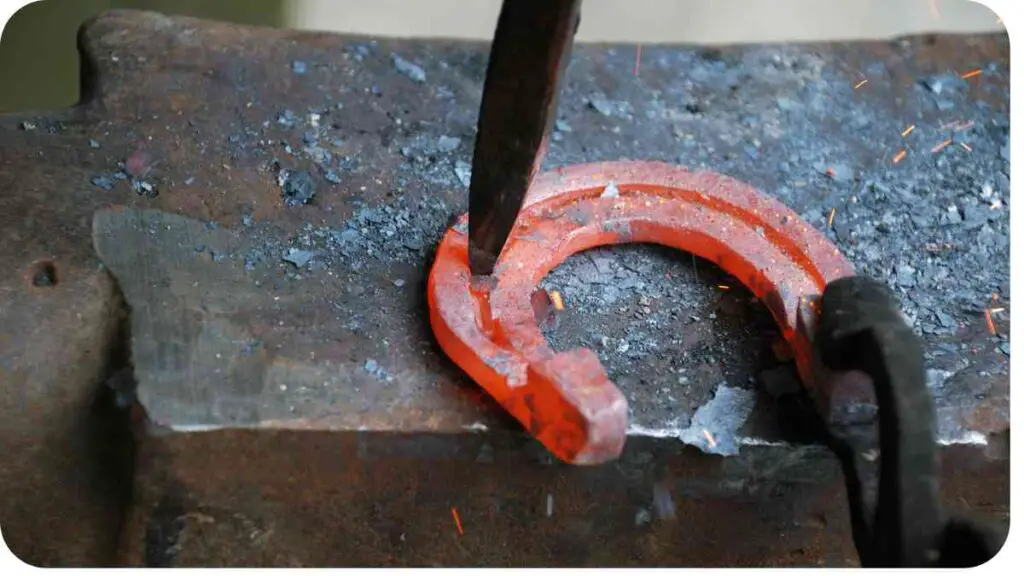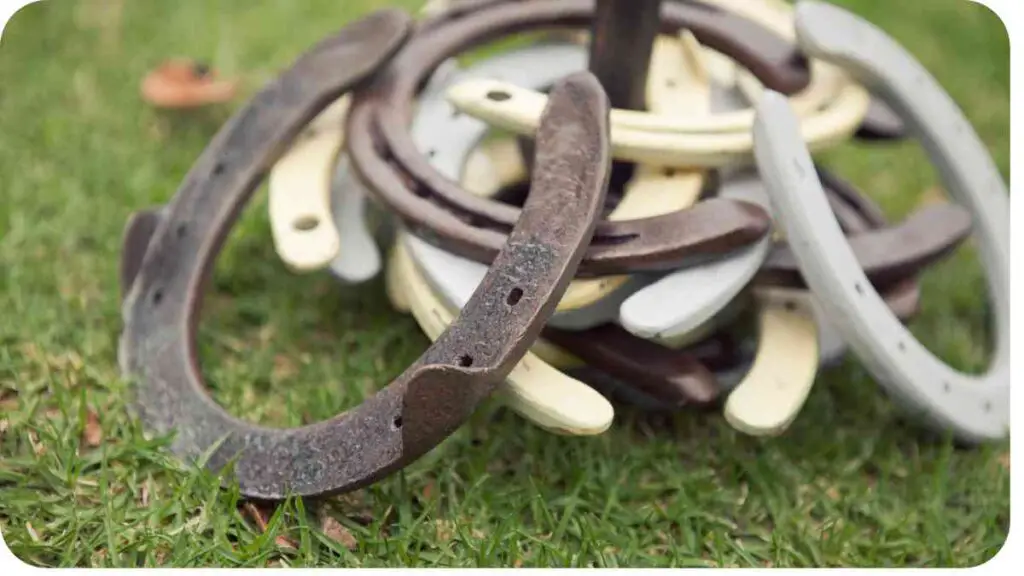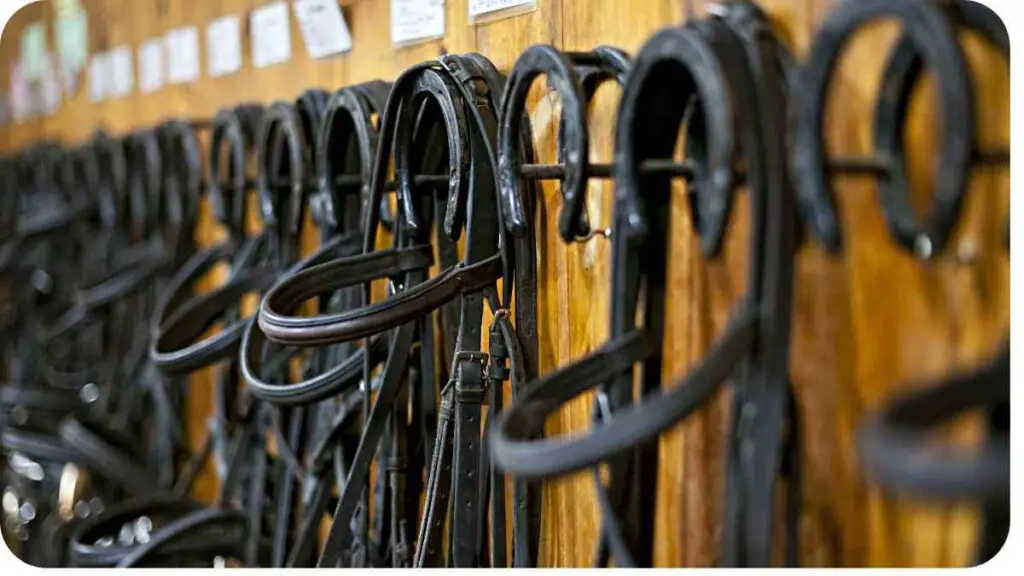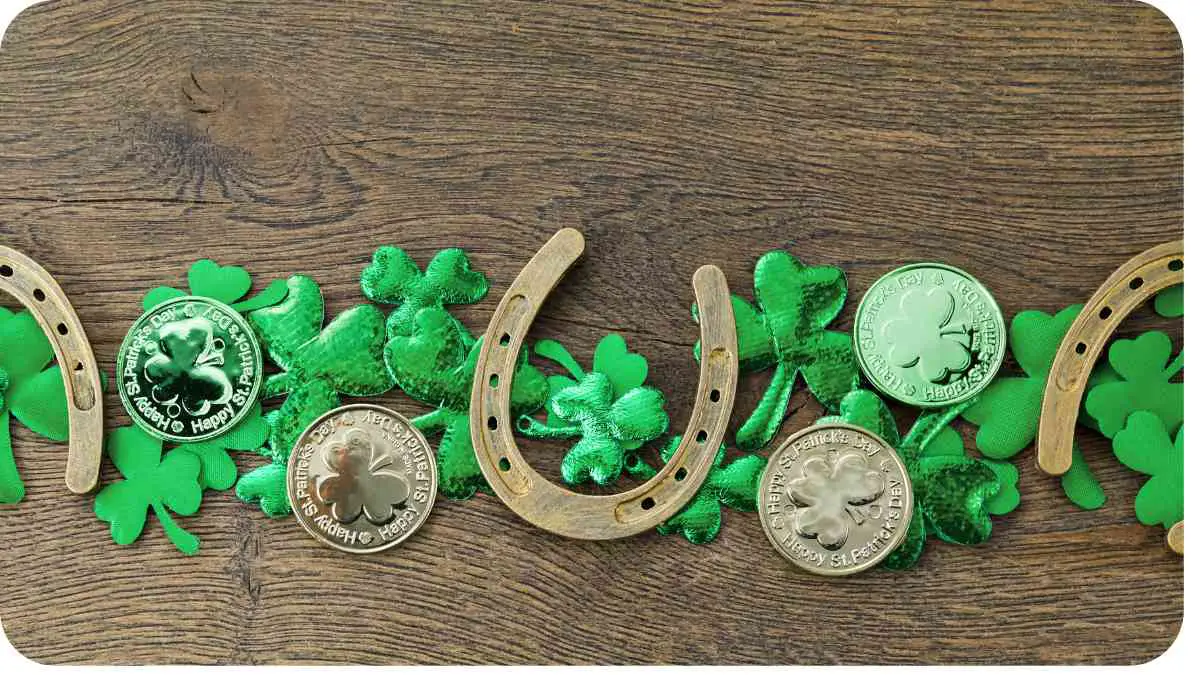Welcome to the world of equine footwear – horseshoes! Whether you’re an avid equestrian or just a curious observer, understanding the purpose and significance of horseshoes is essential.
In this comprehensive guide, we’ll delve into the history, types, and importance of horseshoes, providing insights into their role in maintaining equine health and performance.
| Takeaways |
|---|
| 1. Evolution of Design: Understand the historical journey of horseshoes, from simple protective coverings to modern, specialized designs. |
| 2. Types of Horseshoes: Explore traditional metal, synthetic, and specialty horseshoes, each serving unique purposes in equine care. |
| 3. Importance in Equine Health: Recognize how horseshoes provide support, protection, and address hoof issues, contributing to overall equine well-being. |
| 4. Choosing the Right Horseshoes: Consider factors like size, fit, material, and shoeing techniques for optimal horse performance and comfort. |
| 5. Role of the Farrier: Appreciate the skill and expertise of farriers in the horseshoeing process and their role in maintaining hoof health. |
| 6. Debunking Myths: Challenge common misconceptions about horseshoes, such as the belief that they universally cause discomfort. |
| 7. Discipline-Specific Considerations: Explore how horseshoes vary based on different riding disciplines like racing, dressage, and jumping. |
| 8. DIY Maintenance Tips: Learn practical tips for horse owners to ensure regular checks, cleaning, and oiling for horseshoe maintenance. |
| 9. Innovations in Technology: Stay informed about smart horseshoes and eco-friendly alternatives, showcasing the technological advancements in equine footwear. |
| 10. Real-world Insights: Gain insights from case studies, both success stories and challenges, illustrating the impact of horseshoes on equine performance. |
| 11. Tips for Success: Understand the importance of regular check-ups, building a strong relationship with your farrier, and adopting a holistic approach to horse care. |
2. History of Horseshoes

Horseshoes have a rich history dating back centuries. Initially, horses were left unshod, but as human societies evolved, so did the need for protective footwear for these noble creatures. The historical journey of horseshoes is an intriguing tale of innovation and necessity.
Table 2.1: Evolution of Horseshoe Design
| Era | Horseshoe Material | Design Features |
|---|---|---|
| Ancient Times | Leather and plant fibers | Simple protective coverings |
| Middle Ages | Iron | Basic U-shaped designs for added durability |
| Modern Era | Various alloys | Customized shapes for different purposes |
3. The Evolution of Horseshoe Design
Advancements in metallurgy and craftsmanship over time have significantly influenced horseshoe design. Today, horseshoes come in various shapes and materials, each serving specific purposes. Let’s explore the evolution of these crucial equine accessories.
Table 3.1: Types of Horseshoes
| Type | Material | Common Usage |
|---|---|---|
| Traditional Metal | Steel or aluminum alloy | General-purpose, durability, and traction |
| Synthetic | Rubber or plastic | Injury prevention, shock absorption |
| Specialty | Varied materials | Disciplinary-specific, e.g., racing plates |
4. Types of Horseshoes

Understanding the different types of horseshoes available is crucial for horse owners and enthusiasts. Whether you’re looking for traditional metal shoes, synthetic alternatives, or specialty options, each has its unique benefits.
4.1 Traditional Metal Horseshoes
Traditional metal horseshoes, often made of steel or aluminum alloys, provide durability and traction. They are widely used in various equestrian activities, from casual riding to competitive sports.
4.2 Synthetic Horseshoes
Synthetic horseshoes, crafted from materials like rubber or plastic, have gained popularity for their unique benefits. These horseshoes offer excellent shock absorption, reducing the impact on a horse’s joints and hooves. They are particularly useful in preventing injuries, making them a preferred choice for some horse owners.
Table 4.2: Advantages of Synthetic Horseshoes
| Advantage | Description |
|---|---|
| Shock Absorption | Reduces impact on joints and hooves |
| Injury Prevention | Minimizes the risk of certain hoof-related injuries |
| Lightweight | Easier for horses to carry, potentially improving agility |
4.3 Specialty Horseshoes
Specialty horseshoes are designed for specific disciplines within the equestrian world. Racing plates, for instance, are tailored for the high-speed demands of horse racing. Understanding these specialty options is vital for ensuring the right fit for your horse’s unique needs.
Table 4.3: Disciplinary-specific Horseshoes
| Specialty | Common Usage |
|---|---|
| Racing Plates | Lightweight for high-speed racing |
| Dressage Shoes | Provides support for intricate movements |
| Jumping Shoes | Enhances traction during jumping |
5. Importance of Horseshoes in Equine Health
Horseshoes play a pivotal role in maintaining the health and well-being of horses. Let’s delve into the key reasons why they are essential for our equine companions.
5.1 Support and Protection
One of the primary functions of horseshoes is to provide support and protection to a horse’s hooves. The hooves, though strong, can be susceptible to wear and tear, especially in demanding activities. Horseshoes act as a protective barrier, preventing injuries and promoting overall hoof health.
Table 5.1: Benefits of Horseshoes for Support and Protection
| Benefit | Description |
|---|---|
| Injury Prevention | Shields hooves from rocks, uneven terrain, and debris |
| Support during Activity | Distributes weight evenly, reducing strain on hooves |
| Prevents Excessive Wear | Minimizes natural wear and tear, promoting hoof health |
5.2 Correcting Hoof Issues
Horseshoes are also instrumental in addressing various hoof issues. Whether a horse has imbalances, abnormalities, or specific gait concerns, skilled farriers can use customized shoeing techniques to correct these problems. This corrective aspect of horseshoeing contributes significantly to the horse’s overall soundness.
Table 5.2: Common Hoof Issues and Corresponding Horseshoe Solutions
| Hoof Issue | Corresponding Horseshoe Solution |
|---|---|
| Uneven Wear | Customized trimming and shoeing techniques |
| Overgrown Hooves | Proper trimming and shaping for balance |
| Gait Abnormalities | Shoe modifications to encourage proper movement |
5.3 Preventing Injuries
Horseshoes are a key element in preventing injuries to the hooves and lower limbs of horses. In various disciplines, such as jumping or racing, the risk of injury is heightened. Properly fitted horseshoes, coupled with expert shoeing techniques, can significantly reduce the likelihood of injuries, ensuring the horse’s longevity and performance.
Table 5.3: Injury Prevention with Horseshoes
| Discipline | Common Injuries | Horseshoe Interventions |
|---|---|---|
| Jumping | Tendon and ligament strains | Shock-absorbing horseshoes |
| Racing | Hoof impact injuries | Lightweight, durable racing plates |
| Dressage | Uneven stress on hooves | Supportive, balanced horseshoes for intricate moves |
6. Choosing the Right Horseshoes

Selecting the appropriate horseshoes for your horse involves considering various factors. Size, fit, material, and shoeing techniques all play a crucial role in ensuring optimal performance and well-being.
6.1 Size and Fit
Choosing the right size and fit for horseshoes is paramount for their effectiveness. Ill-fitted shoes can lead to discomfort, lameness, and even injury. Working closely with a knowledgeable farrier ensures that the horseshoes are tailored to your horse’s individual hoof shape and size.
Table 6.1: Key Considerations for Size and Fit
| Consideration | Description |
|---|---|
| Hoof Measurement | Accurate measurement for proper sizing |
| Customization | Tailoring horseshoes to individual hoof shape |
| Regular Inspections | Periodic checks for changes in hoof size or shape |
6.2 Material Considerations
The material of the horseshoes can significantly impact their performance and durability. Traditional metal horseshoes, such as those made from steel or aluminum alloys, offer durability and traction. On the other hand, synthetic horseshoes provide unique benefits like shock absorption. Choosing the right material depends on your horse’s needs and the activities it engages in.
Table 6.2: Pros and Cons of Different Horseshoe Materials
| Material | Pros | Cons |
|---|---|---|
| Traditional Metal | Durability, traction | Heavier, potential for increased wear |
| Synthetic | Shock absorption, injury prevention | May not be as durable in certain conditions |
6.3 Shoeing Techniques
Proper shoeing techniques are as important as the choice of horseshoes. Working with a skilled farrier who understands the specific needs of your horse is crucial. Shoeing techniques can vary based on the horse’s discipline, hoof condition, and any existing issues that need correction.
Table 6.3: Common Shoeing Techniques
| Technique | Description |
|---|---|
| Hot Shoeing | Shaping horseshoes while hot for a customized fit |
| Cold Shoeing | Shaping horseshoes at room temperature |
| Therapeutic Shoeing | Customized shoeing to address specific hoof issues |
7. The Farrier’s Role in Horseshoeing
A skilled and experienced farrier plays a pivotal role in the overall well-being of your horse. Let’s explore the importance of farriers and the process of horseshoeing.
7.1 Farrier Training and Expertise
Farriers are highly trained professionals responsible for the care and maintenance of horses’ hooves. Their expertise goes beyond simply fitting horseshoes – they are skilled in understanding equine anatomy, hoof health, and various shoeing techniques. When seeking a farrier, look for certifications and a solid reputation within the equestrian community.
Table 7.1: Qualities of a Skilled Farrier
| Qualities | Description |
|---|---|
| Certification | Recognized training in farriery |
| Communication Skills | Ability to understand and address horse owner concerns |
| Problem-Solving | Capability to assess and correct hoof issues |
7.2 The Horseshoeing Process
The horseshoeing process is a combination of art and science, requiring precision and a deep understanding of equine biomechanics. Let’s walk through the general steps involved in the horseshoeing process.
Table 7.2: Steps in the Horseshoeing Process
| Step | Description |
|---|---|
| Hoof Assessment | Examination of the horse’s hooves for any issues |
| Cleaning and Trimming | Removal of excess hoof material and shaping for balance |
| Shoe Selection | Choosing the appropriate horseshoes based on horse’s needs |
| Fitting and Nailing | Ensuring a snug fit and securing the horseshoes in place |
| Final Adjustments | Fine-tuning the shoe placement for optimal performance |
8. Common Myths About Horseshoes
Despite the long history and widespread use of horseshoes, several myths persist. Let’s debunk some common misconceptions surrounding these essential equine accessories.
8.1 Myth: Horseshoes Hurt Horses
One prevalent myth is that horseshoes cause pain or discomfort to horses. In reality, when fitted properly by a skilled farrier, horseshoes enhance comfort and protect hooves from potential injuries. Horseshoes are designed to distribute weight evenly, promoting a more natural and balanced gait.
Table 8.1: Addressing the Myth – Horseshoes and Horse Comfort
| Myth | Reality |
|---|---|
| Horseshoes cause pain | Properly fitted horseshoes enhance comfort |
| Horseshoes restrict movement | Correctly designed horseshoes support natural movement |
8.2 Myth: All Horses Need Horseshoes
Contrary to the belief that all horses require horseshoes, some horses can thrive without them. Factors such as hoof health, the horse’s workload, and the terrain it traverses play a role in determining whether horseshoes are necessary. Regular hoof maintenance and consultations with a farrier can help make the right decision for each individual horse.
Table 8.2: Dispelling the Myth – Not All Horses Need Horseshoes
| Myth | Reality |
|---|---|
| All horses need horseshoes | Some horses can thrive without them |
| Horseshoes are a universal requirement | Decisions should be based on individual needs |
9. Horseshoes and Different Riding Disciplines
Horseshoes play a vital role in various riding disciplines, each with its specific demands. Let’s explore how horseshoes are tailored for different activities, from racing to dressage.
9.1 Horseshoes in Racing
In the world of horse racing, speed and agility are paramount. Racing plates, lightweight and durable, are commonly used to enhance performance. These specialized horseshoes provide the necessary traction and support required for horses to navigate the track at high speeds.
Table 9.1: Racing Horseshoes and Performance
| Aspect | Description |
|---|---|
| Lightweight Design | Minimizes additional weight for increased speed |
| Traction Control | Enhances grip on the track surface for improved acceleration |
9.2 Horseshoes in Dressage
Dressage demands precision and intricate movements from horses. Horseshoes designed for dressage focus on providing support and balance, allowing horses to execute movements with grace and ease.
Table 9.2: Dressage Horseshoes and Performance
| Aspect | Description |
|---|---|
| Supportive Design | Provides additional support for intricate movements |
| Balanced Construction | Ensures even weight distribution for optimal performance |
9.3 Horseshoes in Jumping
Jumping disciplines require horses to navigate obstacles with precision and power. Horseshoes for jumping are designed to enhance traction and stability, crucial for a successful leap.
Table 9.3: Jumping Horseshoes and Performance
| Aspect | Description |
|---|---|
| Traction and Grip | Prevents slipping during take-off and landing |
| Shock Absorption | Minimizes impact on joints, reducing the risk of injuries |
10. DIY Horseshoe Maintenance Tips
While farriers play a crucial role in horseshoe maintenance, there are several steps horse owners can take to ensure their horses’ hooves are in optimal condition between farrier visits.
10.1 Checking for Wear and Tear
Regularly inspecting your horse’s hooves and horseshoes is a proactive way to ensure their well-being. Look for signs of wear and tear, such as uneven wear on the horseshoe or any cracks in the material. Addressing these issues promptly can prevent more significant problems from developing.
Table 10.1: DIY Checks for Horseshoe Wear and Tear
| Checkpoint | Action |
|---|---|
| Uneven Wear | Consult with a farrier for adjustments |
| Cracks or Damage | Replace damaged horseshoes promptly |
| Loose Nails | Seek professional assistance to secure horseshoes |
10.2 Cleaning and Oiling
Keeping your horse’s hooves and horseshoes clean is essential for their overall health. Mud, debris, and moisture can accumulate, leading to various issues. Regularly clean the hooves and horseshoes, and consider applying a suitable hoof oil to maintain moisture balance.
Table 10.2: DIY Cleaning and Oiling Routine
| Step | Description |
|---|---|
| Cleaning | Remove mud, debris, and foreign objects from hooves |
| Oiling | Apply a recommended hoof oil to maintain moisture |
| Inspecting | Check for any abnormalities or issues during cleaning |
10.3 When to Consult a Farrier
While DIY maintenance is beneficial, there are instances where professional intervention is necessary. If you notice persistent issues, changes in your horse’s gait, or any signs of discomfort, it’s crucial to consult with your farrier promptly. They can provide expert insights and address any underlying problems.
Table 10.3: Signs to Consult a Farrier
| Sign | Action |
|---|---|
| Lameness or Discomfort | Immediate consultation with a farrier |
| Changes in Gait | Farrier assessment for potential hoof issues |
| Irregular Hoof Growth | Professional evaluation for corrective measures |
11. Innovations in Horseshoe Technology
As technology continues to advance, so does the world of horseshoes. Innovations in materials and design are shaping the future of equine footwear.
11.1 Smart Horseshoes
One of the exciting advancements in horseshoe technology is the emergence of smart horseshoes. Equipped with sensors and technology, these horseshoes can provide valuable data on a horse’s movement, gait, and even signs of distress. This information can be invaluable for both horse owners and farriers in monitoring overall equine health.
Table 11.1: Benefits of Smart Horseshoes
| Benefit | Description |
|---|---|
| Health Monitoring | Tracks changes in gait, providing early signs of issues |
| Performance Enhancement | Analyzes movement for optimization in various disciplines |
| Injury Prevention | Alerts to potential lameness or irregularities |
11.2 Eco-Friendly Horseshoes
As sustainability becomes a priority in various industries, including equestrianism, there is a growing interest in eco-friendly horseshoes. These may be made from recycled materials or feature innovative designs that minimize environmental impact.
Table 11.2: Eco-Friendly Horseshoe Innovations
| Innovation | Description |
|---|---|
| Recycled Materials | Horseshoes crafted from environmentally friendly sources |
| Biodegradable Components | Materials that break down naturally over time |
| Sustainable Manufacturing | Practices that minimize environmental footprint |
12. Case Studies: Horseshoes in Action
Real-world examples provide valuable insights into the impact of horseshoes on equine health and performance. Let’s explore some case studies highlighting both success stories and challenges in the use of horseshoes.
12.1 Success Stories
Case Study: Improved Racing Performance
In the competitive world of horse racing, the right horseshoes can make a significant difference. A thoroughbred named Lightning Bolt showcased remarkable improvement in performance after transitioning to specialized racing plates. The lightweight design enhanced speed, and the horse experienced fewer hoof-related issues, resulting in a series of successful races.
Table 12.1: Success Metrics – Racing Performance
| Metric | Improvement |
|---|---|
| Race Times | Consistent reduction, indicating increased speed |
| Hoof Health | Fewer instances of lameness and injuries |
| Overall Endurance | Improved stamina and endurance during races |
12.2 Challenges and Solutions
Case Study: Dressage and Hoof Sensitivity
In the discipline of dressage, precision is key. A dressage horse named Symphony faced challenges due to hoof sensitivity. Traditional metal horseshoes, despite providing support, were causing discomfort during intricate movements. The farrier collaborated with an equine podiatrist to design specialized shoes that offered both support and flexibility, addressing the sensitivity issue.
Table 12.2: Solutions for Hoof Sensitivity in Dressage
| Challenge | Tailored Solution |
|---|---|
| Hoof Sensitivity | Specially designed shoes for flexibility and support |
| Movement Precision | Enhanced support without compromising performance |
| Farrier-Equine Podiatrist Collaboration | Team effort for holistic hoof care |
13. Tips for Horseshoeing Success
Ensuring the success of horseshoeing involves a combination of informed decisions, regular maintenance, and collaboration with professionals. Let’s explore some tips to make the horseshoeing process smooth and effective.
13.1 Regular Check-ups
Regular check-ups with a farrier are fundamental to maintaining your horse’s hoof health. Schedule routine appointments to assess the condition of the horseshoes, trim hooves, and address any emerging issues. Consistent care can prevent potential problems from escalating.
Table 13.1: Benefits of Regular Horseshoe Check-ups
| Benefit | Description |
|---|---|
| Early Issue Detection | Identifies problems before they become severe |
| Optimal Performance | Ensures horseshoes are well-maintained for peak performance |
| Hoof Health Management | Allows for timely adjustments to support hoof health |
13.2 Building a Relationship with Your Farrier
Establishing a strong relationship with your farrier is crucial for successful horseshoeing. Communication is key – discuss your horse’s needs, any specific concerns, and long-term goals. A collaborative approach between horse owner, farrier, and other equine professionals can contribute to holistic hoof care.
Table 13.2: Elements of a Strong Farrier-Horse Owner Relationship
| Element | Importance |
|---|---|
| Communication | Clear communication of horse’s history and specific needs |
| Collaboration | Working together for the best interests of the horse |
| Trust | Relying on the farrier’s expertise and recommendations |
14. Horseshoes and Horse Health: A Holistic Approach
To truly understand the impact of horseshoes on horse health, it’s essential to adopt a holistic approach. Consider factors beyond just shoeing, such as diet, exercise, and overall well-being. This comprehensive perspective ensures that your horse receives the care it deserves.
14.1 Holistic Care Practices
Integrating a holistic approach to horse care involves looking at various aspects of the horse’s well-being. Beyond horseshoeing, consider the following practices:
Table 14.1: Holistic Care Practices for Horses
| Practice | Description |
|---|---|
| Balanced Diet | Providing a nutritionally balanced diet for overall health |
| Regular Exercise | Incorporating suitable exercise for physical fitness |
| Veterinary Check-ups | Regular check-ups to monitor general health |
| Mental Stimulation | Offering mental stimulation through varied activities |
14.2 Equine Wellness Programs
Some horse owners and professionals are adopting equine wellness programs that encompass a range of therapies and activities to support overall health. These programs may include massage therapy, chiropractic care, and alternative treatments like acupuncture. Such comprehensive approaches can contribute to the horse’s overall well-being.
Table 14.2: Components of Equine Wellness Programs
| Component | Description |
|---|---|
| Massage Therapy | Promotes relaxation and alleviates muscle tension |
| Chiropractic Care | Addresses skeletal issues for improved mobility |
| Acupuncture | Alternative treatment for various health concerns |
15. Conclusion
In conclusion, understanding the purpose of horseshoes goes beyond a mere accessory for horses. Horseshoes play a crucial role in supporting equine health, preventing injuries, and enhancing performance across various disciplines. As a horse owner, collaborating with a skilled farrier and adopting a holistic approach to care ensures your horse’s well-being and longevity.
Remember, the journey of horseshoeing is a continuous process of learning and adaptation. Stay informed, communicate with professionals, and prioritize the individual needs of your horse to provide the best possible care. Your horse’s soles are not just saved; they are set on a path of comfort, support, and optimal performance.
Further Reading
- Understanding the Purpose of Horseshoes: Explore this in-depth article to gain a comprehensive understanding of the purpose of horseshoes, their history, and how they contribute to equine well-being.
- Why Do Horses Need Shoes?: Delve into the reasons behind horses needing shoes and the considerations that horse owners should keep in mind when it comes to hoof care.
- Shoes and Their Uses: Discover the various uses of horseshoes, including their role in different equestrian disciplines, through this insightful article.
FAQs
What is the purpose of horseshoes?
Horseshoes serve multiple purposes, including providing support and protection to a horse’s hooves, preventing injuries, and addressing specific hoof issues.
Do all horses need horseshoes?
No, not all horses require horseshoes. The necessity depends on factors such as hoof health, workload, and the terrain the horse traverses. Regular consultations with a farrier can help determine the individual needs of each horse.
How do I choose the right horseshoes for my horse?
Choosing the right horseshoes involves considering factors like size, fit, material, and the horse’s specific needs. Working closely with a knowledgeable farrier is essential for optimal selection.
Can horseshoes cause discomfort to horses?
When fitted properly by a skilled farrier, horseshoes should not cause discomfort. In fact, well-designed horseshoes enhance comfort, support, and protect the hooves.
Are there alternatives to traditional metal horseshoes?
Yes, there are alternatives, such as synthetic horseshoes made from rubber or plastic. These alternatives offer benefits like shock absorption and injury prevention, catering to specific horse needs.

Hi there! My name is Hellen James, and I’m a horse riding expert. I’ve been riding horses since I was just a kid—and it’s been my passion ever since. But getting started with horse riding can be overwhelming. There’s so much to learn! If you’re looking for a way to get started and make sure you’re doing it right, I’m here to help.


